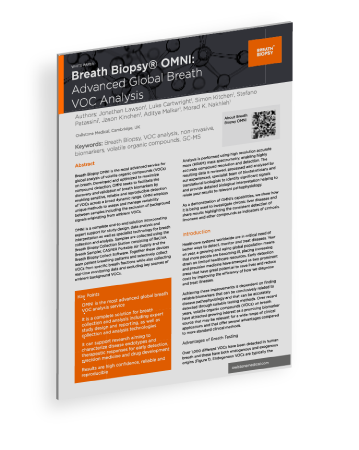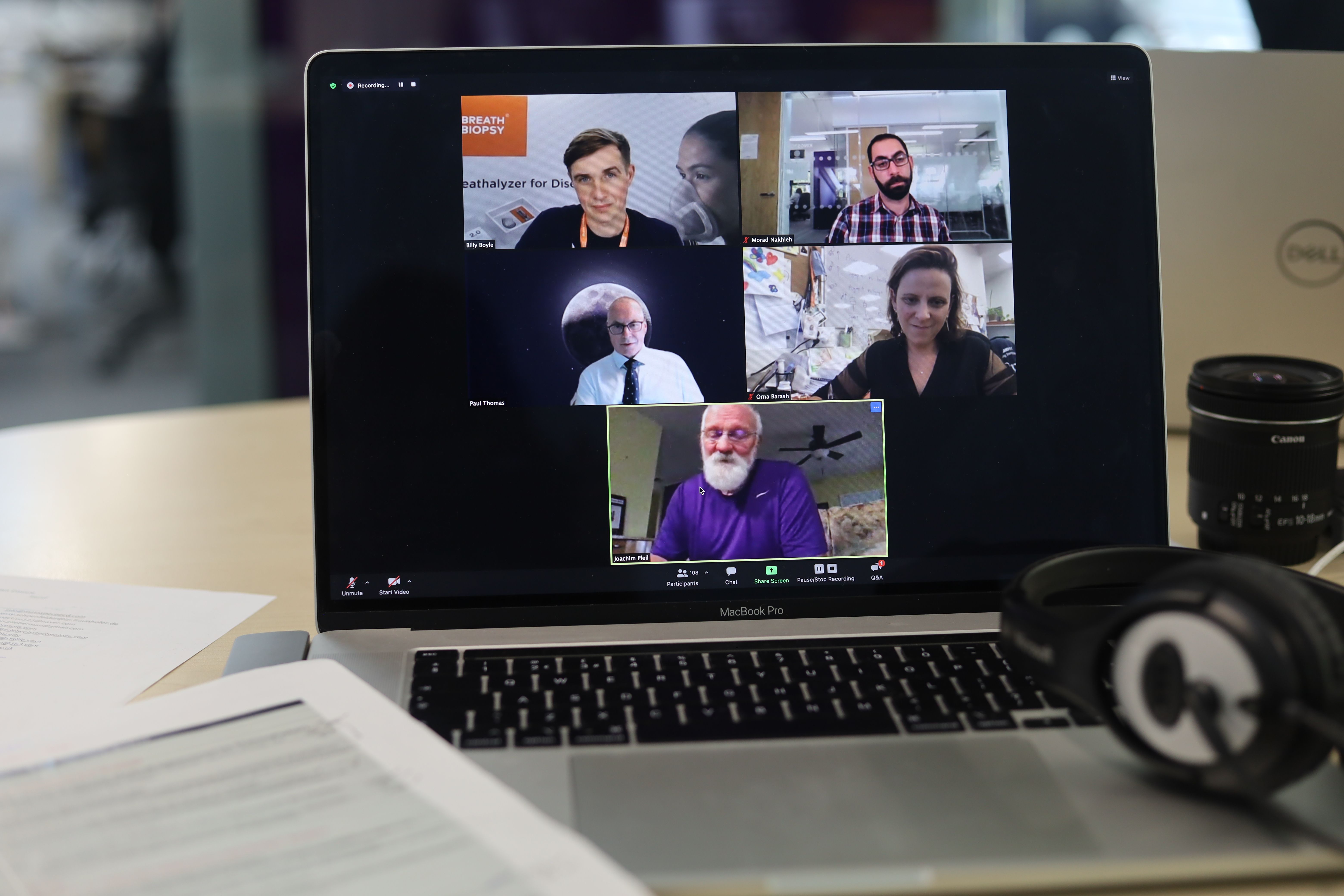Standardization and data sharing at the #BBCon21 panel discussion
Published on: 6 Nov 2021
The Panel Discussion is often one of the most popular sessions at the Breath Biopsy Conference. The theme of this year’s wide ranging and robust discussion was ‘Standardization in the breath research field: How as a community we could benefit from each other’s data’.
From a slightly provocative starting point as each of the panelists mused on ‘how many VOCs there are on breath?’ through to the controversial question of ‘should we bother at all with global breath analysis?’ there were lots of interesting ideas to consider. Contributors this year included:
- Chair: Billy Boyle CEO, Owlstone Medical
- Paul Thomas Professor of Analytical Science, Loughborough University
- Joachim Pleil Professor, Gilings School of Global Public Health
- Orna Barash Research Director, NanoScent Lab
- Morad Nakhleh Lead Biomarker Discovery Scientist, Owlstone Medical
The recorded talks from #BBCon21 are now available to watch online, on demand, including the panel discussion. The following excerpts are taken from our panelists’ responses to two of the questions at the core of this year’s theme.
Catch up on #BBCon21 now Read conference highlights
Should we be standardizing our reporting methodology? [43:00]
Standardization was a key theme of this year’s conference. The panel devoted time to discussing why the current lack of standardization is such a problem for the field, what aspects of breath research it was realistic to work towards standardizing and actions that researchers could take now to allow collective progress to be made in the short-term.
Billy Boyle: When we talk about standardization, the question probably isn’t around standardizing on a given analytical or sampling approach. But should we be standardizing what we report and how we report?
Orna Barash: I find it very difficult to compare multiple studies and conclude anything meaningful. When I look at many papers, each paper refers differently to the data and analysis and reports it differently. Some report databases, some report just in trends, some report in abundance – that makes it really, difficult to compare and to conclude from the literature. It’s a pity and I think we all lose from this.
Joachim Pleil: We are never going to be able to standardize equipment across laboratories But, wearing my editor hat, I see the really diverse ways data is reported. Orna touched on this brilliantly. It is very difficult to compare across laboratory, when everybody figures out their own way of reporting. I think this is where we can make the biggest impact – to say, “Look, whatever you report, at least give me the numbers”.
Paul Thomas: They’ve been [making progress towards standardization] for blood and urinary and other type biomarkers for quite some time now. Breath is different but we can certainly start to adopt guidelines from these other areas, and it’s something that I’m trying to do myself.
Morad Nakhleh: Many groups are limited with funds and end up with small sample size, but that wouldn’t be a problem if we could compare data from multiple studies together and perform meaningful meta-analysis. We could empower those studies together. But for all the reasons that we just mentioned, I don’t think it’s currently possible in our field, as long as we’re not even standardizing the basics of the practice.
Should we make our data freely available? [1.07:50]
Towards the end of the discussion the thorny issue of data sharing was raised with the panel. They discussed issues like the benefits of data sharing, what kinds of data have the most transferable value at the moment and how the wider community could use other people’s data to empower their own work.
Billy Boyle: To what extent should we put our raw data out into the community, so that they can help pick over it and dive into it independently?
Paul Thomas: I was looking at an exquisitely detailed (more than 200 megapixels) image of the moon yesterday, that had been made on a mobile phone. An individual had taken 50,000 images and stacked them all to create it. I thought ‘that’s what we should be doing in breath!’ If I could get that kind of stacking of data, then we would start to get some really definitive resolution there. But to do that is ‘asking for the moon’ at the moment.
Joachim Pleil: What you want to get a handle on is how something changes between people, and how is it different within a person. I think this addresses Paul’s idea of stacking data. The stack could just be two, three or four samples deep but I’ve always encouraged my colleagues to do repeat analyses to remove autocorrelation. Doing things more than once, with some interspersed time, can often answer questions that might otherwise have gone unanswered.
Morad Nakhleh: I think one of the weaknesses that I currently see in publications, is that we don’t know to what extent a result could be coincidental, and therefore, we need to repeat it. What we are doing now is what we call ’breath or blank studies’: we take 10-15 samples from the same dude in the same room and 10-15 background blanks, and then we look into all of those on breath VOCs and see how they behave in a short period of time from the same volunteer. Afterwards we repeat something similar, but with 10 volunteers and we measure the intra and inter individual variability for each of those VOCs. That’s helped us to optimize the reproducibility of our sampling and measurements. I would love to see the community start sharing this data with different collection analytical methods to see what type of variability and reproducibility we see in general in breath.
Orna Barash: It’s good to hear that we all we’re all aligned. I hope that we will manage to take a step forward as a community. I like Morad’s idea of performing quantitative analysis of known VOCs alongside untargeted analysis. It’s a very interesting approach.
Other questions discussed by the panel over the course of slightly more than an hour included:
- How many VOCs are present on breath? How can we be confident these don’t originate from other sources? [2:20]
- Each time we publish experimental results, should we also be simultaneously reporting on the basic performance of our end-to-end systems and workflows? [11:40]
- Should we do away with global analysis in favor of entirely a bottom-up, biological hypothesis-driven approach to biomarker discovery? [29:30]
- How can complimentary orthogonal approaches to breath research be used to confirm results? [58:10]
Watch the full panel discussion
More information on standardization and data sharing
Our blog ‘Designing Studies to Standardize Breath Biomarker Discovery’, was written in partnership with Morad Nakhleh, one of the contributors to this years panel discussion, and unpacks more fully the concept of BoB (breath or blank) studies. You can also find out more on this subject in his recorded presentation from BBCon ‘Towards standardization: Breath Biopsy OMNI Assay for enhanced biomarker detection’ and register to attend the upcoming webinar ‘Breath Biopsy OMNI for comprehensive and reliable detection of VOC biomarkers in breath’ which will feature live Q&A.
Read the blog Watch the BBCon presentation
You are Invited to #BBCon22
The next Breath Biopsy Conference is scheduled to take place on 1–3 November 2022, and is intended to feature both in person (Cambridge, UK) and online sessions. If you would like to join us, please express your interest now and we will contact you when registration opens.



